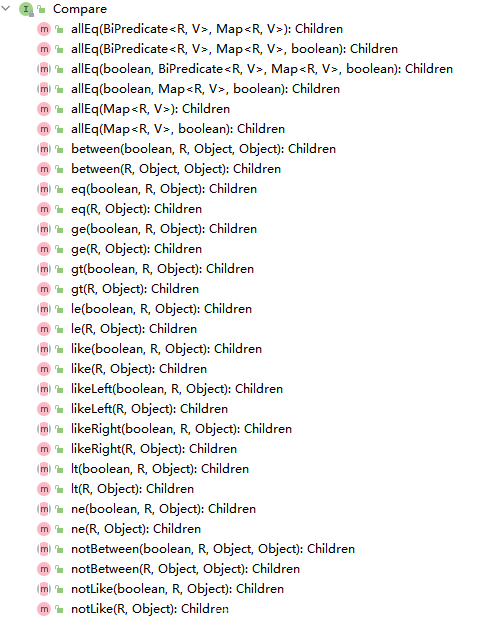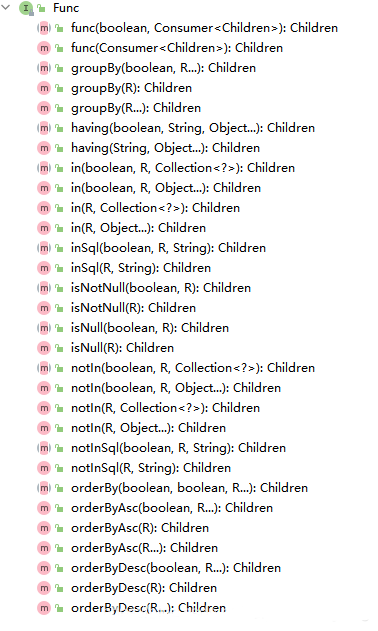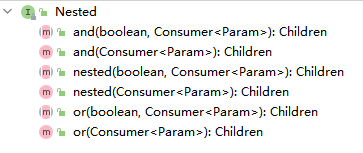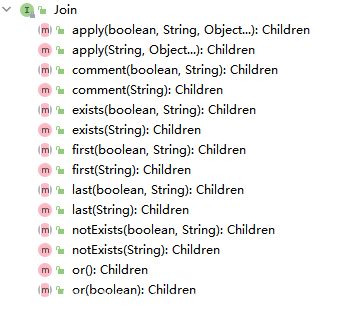简介
说明
本文介绍Mybatis-Plus的条件构造器。
官网网址
大全
| 函数名 | 说明 | 示例 |
| allEq | 全部eq(或个别isNull) | 例1: allEq({id:1,name:”老王”,age:null}) —>id = 1 and name = ‘老王’ and age is null 例2: allEq({id:1,name:”老王”,age:null}, false) —>id = 1 and name = ‘老王’ |
| eq | 等于 = | 例eq(“name”, “老王”)—>name = ‘老王’ |
| ne | 不等于 <> | 例: ne(“name”, “老王”)—>name <> ‘老王’ |
| ge | 大于 > | 例: gt(“age”, 18)—>age > 18 |
| ge | 大于等于 >= | 例: ge(“age”, 18)—>age >= 18 |
| lt | 小于 < | 例: lt(“age”, 18)—>age < 18 |
| le | 小于等于 <= | 例: le(“age”, 18)—>age <= 18 |
| between | BETWEEN 值1 AND 值2 | 例: between(“age”, 18, 30)—>age between 18 and 30 |
| notBetween | NOT BETWEEN 值1 AND 值2 | 例: notBetween(“age”, 18, 30)—>age not between 18 and 30 |
| like | LIKE ‘%值%’ | 例: like(“name”, “王”)—>name like ‘%王%’ |
| notLike | NOT LIKE ‘%值%’ | 例: notLike(“name”, “王”)—>name not like ‘%王%’ |
| likeLeft | LIKE ‘%值’ | 例: likeLeft(“name”, “王”)—>name like ‘%王’ |
| likeRight | LIKE ‘值%’ | 例: likeRight(“name”, “王”)—>name like ‘王%’ |
| isNull | 字段 IS NULL | 例: isNull(“name”)—>name is null |
| isNotNull | 字段 IS NOT NULL | 例: isNotNull(“name”)—>name is not null |
| in | 字段 IN (value.get(0), value.get(1), …) 字段 IN (v0, v1, …) | 例: in(“age”,{1,2,3})—>age in (1,2,3) 例: in(“age”, 1, 2, 3)—>age in (1,2,3) |
| notIn | 字段 NOT IN (value.get(0), value.get(1), …) 字段 NOT IN (v0, v1, …) | 例: notIn(“age”,{1,2,3})—>age not in (1,2,3) 例: notIn(“age”, 1, 2, 3)—>age not in (1,2,3) |
| inSql | 字段 IN ( sql语句 ) | 例: inSql(“age”, “1,2,3,4,5,6”) —>age in (1,2,3,4,5,6) 例: inSql(“id”, “select id from table where id < 3”) —>id in (select id from table where id < 3) |
| notInSql | 字段 NOT IN ( sql语句 ) | 例: notInSql(“age”, “1,2,3,4,5,6”) —>age not in (1,2,3,4,5,6) 例: notInSql(“id”, “select id from table where id < 3”) —>id not in (select id from table where id < 3) |
| groupBy | 分组:GROUP BY 字段, … | 例: groupBy(“id”, “name”)—>group by id,name |
| orderByAsc | 排序:ORDER BY 字段, … ASC | 例: orderByAsc(“id”, “name”)—>order by id ASC,name ASC |
| orderByDesc | 排序:ORDER BY 字段, … DESC | 例: orderByDesc(“id”, “name”)—>order by id DESC,name DESC |
| orderBy | 排序:ORDER BY 字段, … | 例: orderBy(true, true, “id”, “name”)—>order by id ASC,name ASC |
| having | HAVING ( sql语句 ) | 例: having(“sum(age) > 10”)—>having sum(age) > 10 例: having(“sum(age) > {0}”, 11)—>having sum(age) > 11 |
| func | func 方法(主要方便在出现if…else下调用不同方法能不断链) | 例: func(i -> if(true) {i.eq(“id”, 1)} else {i.ne(“id”, 1)}) |
| or | 拼接 OR。 主动调用or表示紧接着下一个方法不是用and连接!(不调用or则默认为使用and连接) | 例: eq(“id”,1).or().eq(“name”,”老王”) —>id = 1 or name = ‘老王’ 例: or(i -> i.eq(“name”, “李白”).ne(“status”, “活着”)) —>or (name = ‘李白’ and status <> ‘活着’) |
| and | AND 嵌套 | 例: and(i -> i.eq(“name”, “李白”).ne(“status”, “活着”)) —>and (name = ‘李白’ and status <> ‘活着’) |
| nested | 正常嵌套 不带 AND 或者 OR | 例: nested(i -> i.eq(“name”, “张三”).gt(“age”, 25)) —>(name = ‘张三’ and age > 25) 例: .eq(“name”, “李四”) .nested(i -> i.gt(“age”, 25).or().lt(“age”, 12)) .eq(“email”, “abc@qq.com”) —>name = ‘李四” AND (age > 25 OR age < 12) AND email = “abc@qq.com” |
| apply | 拼接 sql。 该方法可用于数据库函数动态入参的params对应前面applySql内部的{index}部分。这样是不会有sql注入风险的,反之会有! | 例: apply(“id = 1”) —>id = 1 例: apply(“date_format(dateColumn,’%Y-%m-%d’) = ‘2008-08-08′”) —>date_format(dateColumn,’%Y-%m-%d’) = ‘2008-08-08′”) 例: apply(“date_format(dateColumn,’%Y-%m-%d’) = {0}”, “2008-08-08″) —>date_format(dateColumn,’%Y-%m-%d’) = ‘2008-08-08′”) |
| last | 无视优化规则直接拼接到 sql 的最后。 只能调用一次,多次调用以最后一次为准。有sql注入的风险,请谨慎使用 | 例: last(“limit 1”) |
| exists | 拼接 EXISTS ( sql语句 ) | 例: exists(“select id from table where age = 1”) —>exists (select id from table where age = 1) |
| notExists | 拼接 NOT EXISTS ( sql语句 ) | 例: notExists(“select id from table where age = 1”) —>not exists (select id from table where age = 1) |
Compare功能
com/baomidou/mybatisplus/core/conditions/interfaces/Compare.java

Func功能
com/baomidou/mybatisplus/core/conditions/interfaces/Func.java

nested
com/baomidou/mybatisplus/core/conditions/interfaces/Nested.java

join功能
com/baomidou/mybatisplus/core/conditions/interfaces/Join.java


请先 !